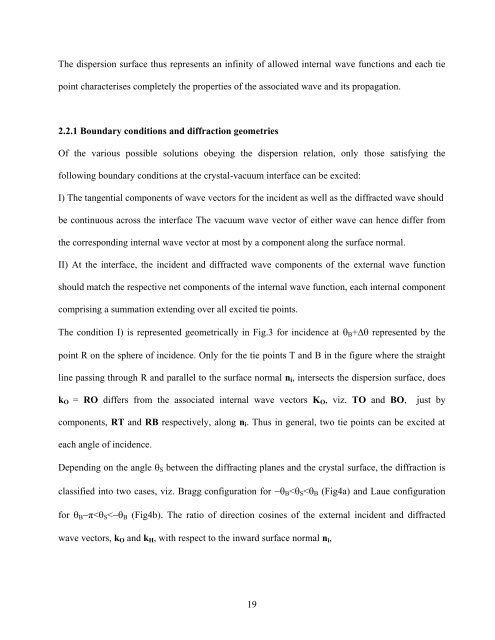PHYS01200804001 Sohrab Abbas - Homi Bhabha National Institute
PHYS01200804001 Sohrab Abbas - Homi Bhabha National Institute
PHYS01200804001 Sohrab Abbas - Homi Bhabha National Institute
You also want an ePaper? Increase the reach of your titles
YUMPU automatically turns print PDFs into web optimized ePapers that Google loves.
The dispersion surface thus represents an infinity of allowed internal wave functions and each tie<br />
point characterises completely the properties of the associated wave and its propagation.<br />
2.2.1 Boundary conditions and diffraction geometries<br />
Of the various possible solutions obeying the dispersion relation, only those satisfying the<br />
following boundary conditions at the crystal-vacuum interface can be excited:<br />
I) The tangential components of wave vectors for the incident as well as the diffracted wave should<br />
be continuous across the interface The vacuum wave vector of either wave can hence differ from<br />
the corresponding internal wave vector at most by a component along the surface normal.<br />
II) At the interface, the incident and diffracted wave components of the external wave function<br />
should match the respective net components of the internal wave function, each internal component<br />
comprising a summation extending over all excited tie points.<br />
The condition I) is represented geometrically in Fig.3 for incidence at B + represented by the<br />
point R on the sphere of incidence. Only for the tie points T and B in the figure where the straight<br />
line passing through R and parallel to the surface normal n i , intersects the dispersion surface, does<br />
k O = RO differs from the associated internal wave vectors K O , viz. TO and BO,<br />
just by<br />
components, RT and RB respectively, along n i . Thus in general, two tie points can be excited at<br />
each angle of incidence.<br />
Depending on the angle S between the diffracting planes and the crystal surface, the diffraction is<br />
classified into two cases, viz. Bragg configuration for B < S < B (Fig4a) and Laue configuration<br />
for B π< S < B (Fig4b). The ratio of direction cosines of the external incident and diffracted<br />
wave vectors, k O and k H , with respect to the inward surface normal n i ,<br />
19
















